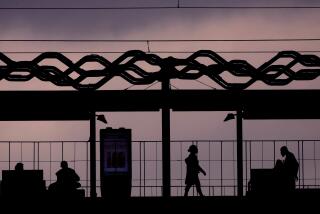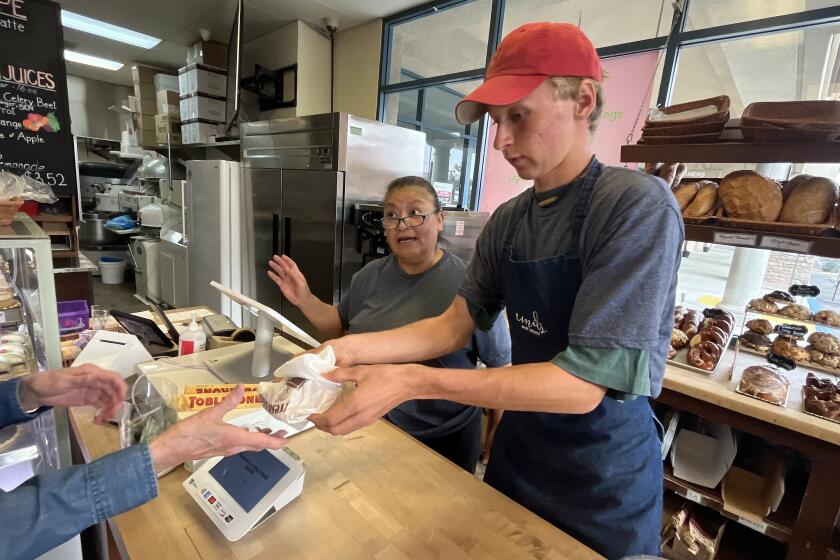Locked Out of Beloved Church, Faithful Keep Its Spirit Alive
Services at St. Isidore Catholic Church these days are like Sundays with the family.
The worshipers who gather weekly at this historic spot have been friends and neighbors for years. Occasionally they bring along tattered photo albums crammed with the faded pictures of weddings and baptisms. And their obvious mutual affection seems nourished by an appreciation for all that they’ve shared.
For the record:
12:00 a.m. Feb. 10, 2005 For The Record
Los Angeles Times Thursday February 10, 2005 Home Edition Main News Part A Page 2 National Desk 1 inches; 47 words Type of Material: Correction
St. Isidore’s -- An article in Monday’s California section about St. Isidore Roman Catholic Church in Los Alamitos said that people gathered in 1922 to build the church, which is believed to be north Orange County’s first Catholic Church. St. Boniface of Anaheim was founded in 1860.
What they’ve also been sharing for at least half a decade, however, is a sense of banishment. For instead of meeting inside the church, where their memories reside, they are locked out of the brown stucco building, unable to celebrate Mass with a priest, because the 83-year-old structure is not considered earthquake-safe.
So instead of worshiping in God’s living room, these devoted parishioners pray in the church social hall, in a separate building -- next to his kitchen.
“Wherever two or more of us are gathered, God is with us,” Ed Rusinek told the 26 worshipers on hand for a recent rosary service in the hall.
“Don’t lose faith,” Rusinek went on. “One day we will have this rosary in the church.”
Most of them last set foot in there in 1999, when the little house of God in Los Alamitos still had a priest saying Spanish-language Masses every Sunday.
“The church was drawing people from all over,” said Father Kenneth Schmit, head pastor at nearby St. Hedwig Catholic Church, under whose authority St. Isidore now resides.
When the Diocese of Orange learned that it would cost about $350,000 to make St. Isidore safe from earthquakes, it decided the money would be better spent elsewhere.
Those who revered the old church -- for the most part, Latino families who’d worshiped there for generations -- formed a group called the Comite del Amor (Committee of Love) to urge that it be restored. They held demonstrations and railed against its closure. They petitioned the bishop for a change of heart.
Nothing worked. And today all they can do is hold weekly rosaries in the social hall, which is shared with the Knights of Columbus, Boy Scouts and Alcoholics Anonymous, just steps away from the locked church that stands as an icon of an era gone by.
That era began in the early part of the last century, when what was to become Los Alamitos was populated mostly by Mexican immigrants, who worked in the beet fields, and Belgian dairy farmers. Together, in 1922, they gathered at this spot off Katella Avenue to build with their own hands what is believed to be north Orange County’s first Catholic Church. They named it after St. Isidore, patron saint of farmers, whose statue still guards the entrance with shovel in hand.
“My grandfather helped mix the concrete to build it,” said Joe Fidel Gomez, 75, who was baptized here in 1930 and later served as an altar boy. “It was built by the farmers who worked in the beet fields and sugar factory. After work on Sundays, they’d come down to help.”
For more than four decades, the little church, which seats about 150 and had several Masses each Sunday, was a dominant force in the community as the city grew up around it. “It was not only a church,” said Rusinek, who serves as the Committee of Love’s unofficial spokesman, “but a community center. This was the center of their social life.”
All that began changing in 1960, when the diocese opened the much larger St. Hedwig, about half a mile south. “The community basically outgrew the church,” said Schmit, who’s been at St. Hedwig since 2001.
St. Isidore kept offering weekly Masses -- conducted in Spanish by a St. Hedwig priest -- but over the years, its devotees say, the old church’s treasures began disappearing. Its familiar bell, which according to Rusinek could be heard for miles on a quiet Sunday morning, was given to a visiting priest from New Guinea. “The last we heard,” Rusinek said, “it was at a church in Ireland.”
Nobody knows what, exactly, happened to the magnificent white marble altar, imported from Belgium. And all of the original wooden pews, Rusinek said, have been replaced by oddly sized hand-me-downs. But the beautiful stained glass windows remain.
Recently the worshipers have felt a fresh breeze of hope.
Reopening St. Isidore as a functioning Catholic church with weekly Masses is not on the table, according to Schmit. But if parishioners can get the earthquake retrofitting done, it’s conceivable to open the church as an unstaffed chapel in which people can worship as they please, without scheduled Masses.
Rusinek says his committee is exploring how to finance the work through public fundraisers and private donations of money and labor. The planning, he says, is in the early stages.
In the meantime, the worshipers still have those Sundays by the kitchen.
“This is like a tower of hope for the city,” said Maria Teresa Diaz, who began attending St. Isidore in the 1970s. “This is the center. It all started here.”
Added Rusinek: “We come here to keep the people together. Even though they closed the church, God is still waiting for us in there.”
More to Read
Sign up for Essential California
The most important California stories and recommendations in your inbox every morning.
You may occasionally receive promotional content from the Los Angeles Times.










